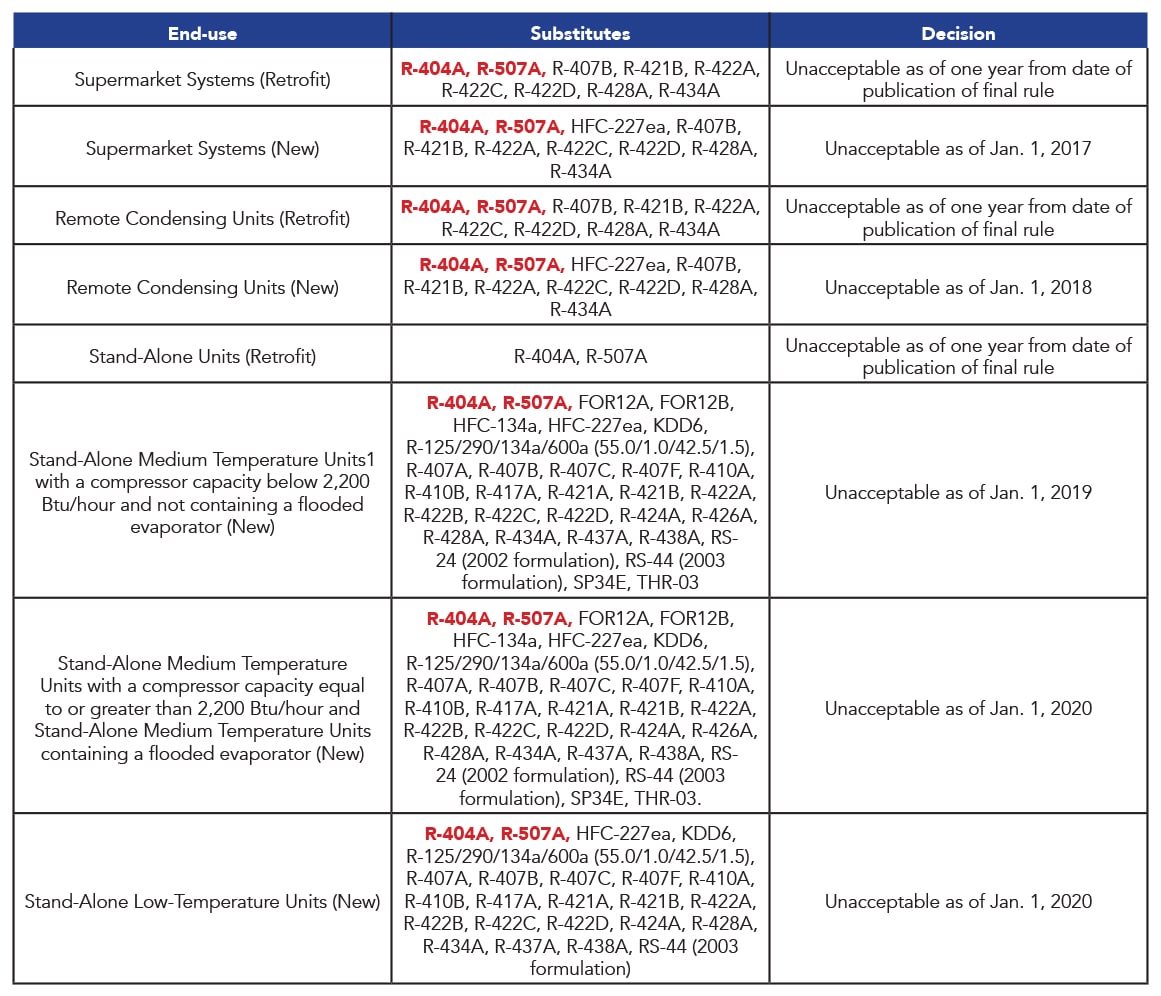Prepare for Refrigerant Regulation Changes; Future-Proof Your Business

EPA’s SNAP Phaseout Schedule for Alternative Refrigerants
The wait is over. Food retailers and the refrigeration industry were in a holding pattern for months while the U.S. Environmental Protection Agency considered its next move on alternative refrigerants. Then, in mid-July, a 90-page ruling published in the Federal Register (pp. 42870-42959) confirmed what Hillphoenix and other industry experts had anticipated: Widely used refrigerants R-404A and R-507A would join the list of alternatives being phased out under the EPA’s Significant New Alternatives Policy (SNAP) program. Now retailers and manufacturers have the facts. Like the ruling or not, the industry finally can take action.
So, what are the right next steps? After digging into the ruling and talking to other manufacturers, we’ve created this guide to help food retailers better understand the R-404A and R-507A phaseout; gain some insights into the regulatory forces reshaping industry operations; and think through the options available to them as the phaseout dates draw near.
Grading Global Warming Potential
Let’s start with a little background. The EPA aims to reduce the use of substances with potential to harm the environment. One of the metrics used to evaluate environmental effect is global warming potential (GWP); substances with a higher GWP (see chart below) are considered more harmful. That’s why R-404A and R-507A were suspected to be on the phaseout list, and Hillphoenix began issuing communications in April that advised our food-retailing customers to consider other options.
Global Warming Potential of Common Commercial Refrigerants: The EPA has targeted R-22, R-404A and R-507 for phaseout.
A Brief History of Refrigerants and Regulation
What are now considered “new” alternative refrigerants actually date back more than 100 years. When refrigeration was in its early stages in the late 1800s and early 1900s, CO2, ammonia and other natural refrigerants dominated. But by the late 1920s, researchers began working on organic fluoride-based cooling compounds. The first among them was synthesized dichlorodifluoromethane, or R-12. In 1930, fluorocarbon refrigerants were introduced to the market and quickly became the standard. It took more than half a century for the industry and regulators to recognize their environmental impact.
In 1987, the Montreal Protocol, an international environmental agreement, established the phaseout of chlorofluorocarbons. Scientists had determined that CFCs were contributing to the depletion of the ozone layer, a shield from solar radiation. Additional international environmental agreements followed, resulting in mandated reductions of chlorofluorocarbons, hydrofluorocarbons and hydrochlorofluorocarbons to curb both ozone depletion and the global-warming effects of CFCs, HFCs and HCFCs. The EPA has continuously tightened restrictions on HCFC production and use. By 2030, it will completely ban HCFC production and importation.
Hillphoenix got ahead of the changes. In the mid-1990s, we introduced one of the first cooling technologies to reduce global-warming emissions, and we continue to move sustainable technologies from the lab to the marketplace. Our environmental improvements in alternative refrigerants and energy efficiency have helped take more than 2 billion pounds of harmful emissions out of the atmosphere since 1996. Today, about a quarter of our business comes from our Second Nature line of alternative refrigeration systems.
Looking Ahead: How Retailers Can Cope with Changes and Step Off the Regulatory Treadmill
While the entire industry is grappling with refrigerant phaseouts, the situation is different for every food retailer. Your existing refrigeration equipment and the refrigerant it uses matters, as does your climate and location. (If you operate stores in California, for example, you may need to do even more to reduce high-GWP substances.) The first thing to do is ask for help. At Hillphoenix, we understand your refrigeration equipment, alternative refrigerants and what’s happening with regulations. We were a founding partner of the EPA’s GreenChill Partnership, and last year were among a select group of companies invited to the White House for an Industry Leader Roundtable to be recognized and discuss reducing greenhouse-gas emissions and increasing energy efficiency for the food-retailing industry. We’ve also installed more alternative refrigeration systems across North America than any other manufacturer in our industry.
While there’s no one-size-fits-all solution to regulatory compliance, here’s a broad overview of what we are advising customers to do:
- Transition away from R-404A and R-507A to a lower-GWP refrigerant.
- Choose refrigeration system technologies that require the lowest possible amount of refrigerant.
- Craft a two-prong strategy that addresses refrigerant changes and U.S. Department of Energy energy efficiency requirements for commercial refrigeration at the same time.
- Consider switching to natural refrigerant systems that reduce your dependence on the medium- and high-GWP refrigerants that regulators will continue to scrutinize. You might be able to modify your existing system to use lower-GWP refrigerants such as CO2.
- Request SNAP approval for R-404A/R-507A-like replacements, such as R-448A and R-449A for self-contained equipment.
- Continue to request that the EPA and DOE better coordinate future regulatory actions.
- Stay abreast of technology changes and new refrigerant releases by keeping in contact with Hillphoenix and other industry resources.
- Ensure staff and contractors are properly trained to work safely and effectively with new refrigerants and equipment. Here, again, Hillphoenix can help through our Learning Center, which has trained 25,000 industry professionals over the past decade.
- Check your contractors’ qualifications and certifications, and communicate your requirements for leak detection and repair to them.
- Be prepared for EPA in-store inspections.
Additional Resources
Complete Ruling: Protection of Stratospheric Ozone: Change of Listing Status for Certain Substitutes Under the Significant New Alternatives Policy Program FinalRule, Federal Register, pp. 42870-42959
Factsheet: Change of Listing Status for Certain Substitutes under the Significant New Alternatives Policy Program, EPA’s SNAP program
Webcast: EPA’s Final Refrigerant Ruling: Its Impact on Your Business, Emerson Climate Technologies